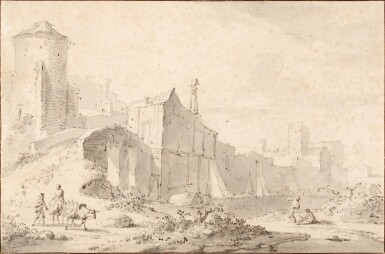Old Master Paintings & Works on Paper Day Auction
Old Master Paintings & Works on Paper Day Auction

Property from the Ehlen Collection
Jan Baptist Weenix
Travellers by a bridge, outside the walls of a town
No reserve
Lot closes
July 4, 11:35 AM GMT
Estimate
3,000 - 4,000 GBP
Current Bid
700 GBP
7 Bids
No reserve
Lot Details
Description
Property from the Ehlen Collection
Jan Baptist Weenix
Amsterdam 1621 - 1659 Haarzuilens
Travellers by a bridge, outside the walls of a town
black chalk and grey wash
184 by 278 mm
Jan Baptist Weenix is a fascinating, and still perhaps not totally well understood, draughtsman, whose drawings are rather rare. Perhaps the most complete summary of their range and evolution is to be found in Peter Schatborn’s definitive account of the activities of Dutch landscape artists working in Italy, published in connection with the Rijksmuseum’s 2001 exhibition, Drawn to Warmth: 17th-century Dutch artists in Italy.
According to the early biographer Arnold Houbraken, who got his information from the artist’s son, Jan Weenix (1641-1719), the elder Weenix studied with both Abraham Bloemaert and Nicolaes Moyaert. In the handful of drawings that are known from Weenix’s early career, such as the Sheep and shepherd by a Large Tree, in the Albertina, Vienna, which is signed and dated 1641, the influence of both of Weenix’s teachers is evident, as is also the artist’s own very distinctive handling, which often combines lyrical, expansive shading (in chalk or wash) with characteristic strong accents of black chalk.1
Having promised his young wife that he would stay away no more than four months, Weenix travelled to Italy in 1643, remaining there for four years, and receiving commissions from important patrons, including Cardinal Camillo Pamphili and his relative Giovanni Battista Pamphili, who in 1644 became Pope Innocent X. During these years, expansive, broadly applied washes become a more significant element in Weenix’s drawing style, and he also seems to have discovered red chalk, a medium little used by his northern contemporaries. A good example of such a red chalk drawing is the Road through the Rocks, in Munich (Schat Fig H), which is also signed with the Italian form of the artist’s name that he employed from this time on.2
After his return to The Netherlands, these different elements seem to have become more harmoniously balanced within Weenix’s style, as one sees in a drawing such as the elaborate Ruins of the Huis ter Kleef, in the Albertina, which was probably made just after he got back from Italy in 1647.3 Perhaps closest of all to the present sheet in terms of style is a drawing in Bremen, depicting a view near Harderwijk.4
Though the location depicted in this drawing seems perhaps not totally Dutch, the style seems much closer to Weenix’s later drawings, made after his return north, than to those that he made in Italy.
- Vienna, Albertina, inv. 9560; P. Schatborn, Drawn to Warmth: 17th-century Dutch artists in Italy, Amsterdam 2001, p.110, Fig A
- Ibid., p. 114, Fig H
- Vienna, Albertina, inv. 9561
- A.A. van Wagenberg-Ter Hoeven, Jan Baptist Weenix, The Paintings, Zwolle 2018, p. 28, fig. 9
You May Also Like









